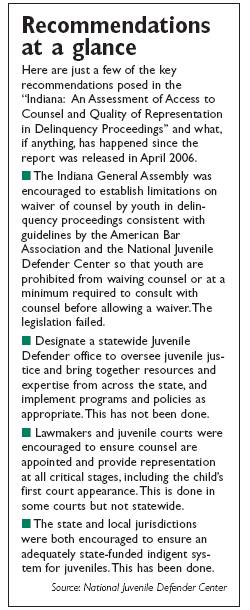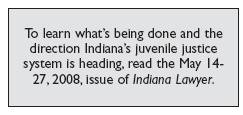Subscriber Benefit
As a subscriber you can listen to articles at work, in the car, or while you work out. Subscribe NowTwo years after a comprehensive study revealed the shocking depth of flaws in Indiana's juvenile justice system and how many kids don't have adequate access to counsel, the state is lagging on reform and isn't as far as some expected it might be by now.
Don't get the wrong idea reforms are happening and the juvenile justice system is being glued together in pockets of Indiana. The state's largest county has seen significant changes in its juvenile system, to the point where it's getting national accolades for innovation. Lawmakers have tried, failing on some sweeping reforms but most recently addressing the costly task of juvenile detention and child welfare funding as part of a massive property tax reform effort. Some worry about the effects of that, but judges statewide remain excited about their local initiatives and continue working hard in their own corners of the state.
In studying post-report action in other states, disappointment from report authors, scattered reforms in Indiana, and firsthand views from attorneys and judges in the trenches, the Hoosier state is not yet where it should be.
Juvenile justice still varies significantly depending on the county and jurisdiction where the proceedings are taking place.
"It's been slow compared to other states that have done this," said Kim Brooks Tandy, a lawyer who serves as director of the Children's Law Center and was principal author of "Indiana: An Assessment of Access to Counsel and Quality of Representation in Delinquency Proceedings.""There hasn't been a concerted effort, and Indiana has a long way to go."
The report
Understanding where Indiana is now and where it must go in the future means a necessary look at the assessment released in April 2006.
Commissioned by the Indiana Juvenile Justice Task Force, a team of juvenile justice advocates with the National Juvenile Defender Center and Children's Law Center set out to learn where the state stood on legal representation of juveniles and how the statewide juvenile justice system could be improved. About 16 similar studies have been done nationally.
The comprehensive report revealed shocking examples and alarming trends in Indiana's juvenile justice system as it focused on waiving access to counsel, quality of representation, and systematic barriers that impact juvenile representation.
Findings showed about half of youth routinely waived their right to counsel and therefore didn't have an adequate understanding of their rights and the benefits of representation. About 40 percent of youth proceeded through court without counsel, and the rate hit as high as 80 percent in at least two jurisdictions.
The study found that early consultation with an attorney was key to a juvenile's decision making. When a youth consulted with a lawyer, 38.6 percent never waived their right to counsel and 50 percent rarely waived that right. But when a youth consulted with only a parent, 47.7 percent often waived their right to counsel and 22.7 percent sometimes waived the right, the report found.
Investigators often found the quality of representation provided for Indiana's indigent youth depended on the person appointed. Zealous and dedicated advocacy wasn't the norm.
After the report's release, many responded that they'd heard anecdotal evidence of the problem but they didn't truly understand the magnitude of the issues.
They vowed change.
"I was outraged by the report, but obviously not everyone was," said Larry Landis with the Indiana Public Defender Council. "There hasn't been radical reform. It's almost as though the report comes out, says something shocking and everyone goes ‘ho hum.'"
 Now, figures show Indiana's juvenile courts have seen more than a 5 percent increase in the number of cases from the 2004 figure used in the report from 68,739 then to 72,501 last year. Dispositions have gone from about 60,799 then to 64,896 nearly a 7 percent change. Caseloads continue increasing at the local level, where those in the trenches say adequate representation depends on the county and available funding.
Now, figures show Indiana's juvenile courts have seen more than a 5 percent increase in the number of cases from the 2004 figure used in the report from 68,739 then to 72,501 last year. Dispositions have gone from about 60,799 then to 64,896 nearly a 7 percent change. Caseloads continue increasing at the local level, where those in the trenches say adequate representation depends on the county and available funding.
Bill Glick, executive director of the Indiana Juvenile Justice Task Force, has witnessed some localized changes especially in Marion County but hasn't observed widespread change statewide.
He said the picture illustrated in the report is about the same now, two years later: that public defense for indigent juveniles is spotty in some places, and the quality of representation varies based on the size of the county and juvenile court.
"As to how it's penetrated the rest of the state, the report hasn't made the impact on public policy we would've hoped for by now," he said. "We're a nonprofit task force and don't really have a way to measure that, so we don't know what might be the impact. I'd like to have an answer to that question myself."
What has been done?
While most agree that systematic changes haven't been put in place, they point to examples of smaller efforts that are successfully transforming the system at the trial level.
"We are moving, slowly but surely. We're trying to take some steps and move forward in the right direction," said Amy Karozos, a staff attorney with the Youth Law T.E.A.M. of Indiana and chair of the Indiana State Bar Association's Civil Rights of Children Committee.
Statewide, Indiana is trying to increase the related training for public defenders through the Indiana Public Defender Council, Karozos and Landis said. Lawmakers have gradually increased the reimbursement to counties for indigent defense in all non-capital cases, including juvenile cases, most recently raising the amount from $14.5 million to $15.25 million starting July 1. About 51 counties participate and are eligible to receive reimbursement for 40 percent of indigent defense in non-capital cases.
 Meanwhile, grants have allowed counties to establish and strengthen family court projects and mental-health efforts, including juvenile diversion programs in Porter, Tippecanoe, and Lake counties. Federal grants from the MacArthur Foundation are also being investigated to test new, innovative ideas.
Meanwhile, grants have allowed counties to establish and strengthen family court projects and mental-health efforts, including juvenile diversion programs in Porter, Tippecanoe, and Lake counties. Federal grants from the MacArthur Foundation are also being investigated to test new, innovative ideas.
In Marion County, the court is being viewed as a state and national model for innovation with the creation of an initial hearing court. Officials there are working with the Annie E. Casey Foundation and a federal grant to find alternatives to detention and work to hit at the roots of juvenile crime.
Through all of that, the ISBA's committee, along with other state and court groups designed to tackle juvenile justice issues, continue working to connect dots and make improvements across the board.
Lake Superior Juvenile Judge Mary Beth Bonaventura sees her jurisdiction as handling access to counsel better than others, mostly because of the county cooperation in offering resources.
"When you're doing this day in and day out, and then read about how children's rights aren't being honored in some places, it makes it more real of how serious this is," the judge said. "It makes you question whether you're protecting these rights of children and families the best you can. By practice, we've always done that. But this makes you question it."
In Porter County, Juvenile Judge Mary Harper pointed out that the county has always been focused on adequate juvenile justice, but it has added some public defenders since the report's release to better ensure children have adequate representation. The county offers multiple diversion programs, including a mental health diversion program that other counties are using as part of a statewide pilot program.
"It's still county-to-county," said Kaarin Lueck, a Wayne County public defender who handles most of the local juvenile cases. "We don't ask if they want to waive (counsel), and provide it automatically most of the time, but that's different from what I understand happens in more rural counties where most juveniles go unrepresented."
Lueck said she's able to meet with most of her detained juveniles for about 30 minutes at most before a court hearing, which can be a challenge because the lawyer is trying to explain not only what's happening with the client's case but also the basics of what will occur in the courtroom.
"Juvenile defense overall still has some significant issues to address," she said.
Finding guidance nationally
 A Justice Policy Institute report from late 2007 indicates the pace of juvenile justice reform is accelerating and about half of the states have started some sort of reform. Fives states California, Illinois, Mississippi, Oklahoma, and Texas have implemented systematic changes while a handful of other states, including Indiana, are taking smaller steps.
A Justice Policy Institute report from late 2007 indicates the pace of juvenile justice reform is accelerating and about half of the states have started some sort of reform. Fives states California, Illinois, Mississippi, Oklahoma, and Texas have implemented systematic changes while a handful of other states, including Indiana, are taking smaller steps.
While efforts show Indiana's juvenile justice system is improving, the Access to Counsel report's co-author and those studying this issue remain critical of the lack of progress in the past two years. They are hopeful and pleased to see what has been done, but they look to efforts in other states that have gone through similar studies as proof that Indiana could have done more by now.
Compared to Kentucky and Ohio, the Hoosier state is behind where they were at this point, Tandy said. Other states have put money into statewide reform; for instance, Kentucky now requires judges to appoint lawyers for youths charged with serious and lesser offenses, such as defying a court order to attend school or stop running away. That law followed a state appellate decision requiring the counsel appointment, she said.
And that is an example of how higher courts can look at rule revisions to provide for consistent and uniform standards, as well as issue opinions that could pave the way for changes in lower courts, Tandy and Karozos said.
A former state public defender herself, Karozos knows that many juveniles don't have an attorney at the admissions process and don't realize they can appeal a juvenile court's decision. An exception is Marion County where the public defender office has an appellate division, so representation is more routine there, she said.
"We can catch some, but it's not systematic and there's not a lot of oversight," she said. "It's really hit or miss whether kids get appeals. If we improve that piece of the picture, we might get changes that way just from appellate caselaw."
That's happened in jurisdictions such as Ohio, where the Ohio Supreme Court held in September in In re: Corey Spears that juvenile defendants must consult with their parents or guardians and a lawyer before deciding to waive their right to legal representation.
The NJDC signed on as an amicus party in the case, and Tandy said the ruling is what other states including Indiana need to see from their courts. The Spears ruling helps strengthen the juvenile trial court and appellate process at the same time, she said.
"When you have a strong appellate system and guidance from the top, there's a significant trickle-down effect for the local level," Tandy said.
Tandy also looks to jurisdictions such as Illinois, Maryland, and North Carolina, where officials have created a separate office within state government to oversee juvenile public defense.
"Something like that would be extremely helpful for Indiana and help bring all the elements together," she said.
Not yet there
So far, Indiana hasn't made the leap.
To make necessary reforms, a state needs to have the legislative, political, and financial support in place, Tandy said. Looking at the report and what other states have done, she speculates that more hasn't been done here simply because of the depth of what needs to be changed.
"These things happen in pieces, and you don't have long-term reform overnight," she said. "This model is the starting point and should give a state some snapshot where its problems are at and a roadmap for reform."
Indiana hasn't yet reached that point, although she is encouraged by recent legislative and state government efforts to change that. Examples include a recentlypassed law shifting funding for juvenile detention facilities from counties to the state, as well as findings in a local government-reform report released in December that included a push for a state-funded public defender system.
While many of the recommendations aren't included in the finalized property tax law, juvenile justice advocates are encouraged that the issue has at least been raised in the report one that included the support of co-author Indiana Chief Justice Randall T. Shepard
 Last year, the General Assembly failed to pass legislation that would have prohibited juveniles from waiving counsel and prevent them from making statements during mental-health screenings, assessments, and treatment as evidence in a delinquency hearing or adult court hearing.
Last year, the General Assembly failed to pass legislation that would have prohibited juveniles from waiving counsel and prevent them from making statements during mental-health screenings, assessments, and treatment as evidence in a delinquency hearing or adult court hearing.
But lawmakers have passed a law that shifts funding of juvenile incarceration, and attempts to reform some aspects of the juvenile justice system as it relates to detention and its alternatives. The detention funding issue is being considered in the Indiana Court of Appeals, and it's a daunting task in both the budgetary sense and figuratively as the state is ranked as one of the highest in the number of juveniles being locked up.
Karozos is one of many who worry what effect the new law may have as it takes effect periodically in the next year or so. A concern is how much oversight the Indiana Department of Child Services will have, and if that ties the hands of juvenile courts or limits the detention alternatives currently available.
"These changes make it even more important for juveniles to have attorneys present so they can have a voice and there's oversight on the kids' behalf," she said. "As of right now, we're not sure what effects it may have."
All are issues being discussed individually and statewide, in courtrooms and boardrooms, law offices and jail cells, and troubled homes and at office water coolers. Some look to other jurisdictions for innovation ideas. Others are re-examining old laws, thinking outside the box about what's been before them the entire time.
The chief justice looks at where Indiana's moving and sees hope.
"We may not be where we want to end up, but this is suitable for Indiana's long history of local administration," he said. "What's on the doorstep is massive… and how the machinery of it works will be a tremendous project for everyone. We're all in for a period of tremendous transformation as it relates to juvenile justice."
Please enable JavaScript to view this content.
